No CrossRef data available.
Article contents
In Search of ‘Popery and Arbitrary Rule’
Published online by Cambridge University Press: 11 February 2009
Abstract

- Type
- Review Articles
- Information
- Copyright
- Copyright © Cambridge University Press 1977
References
1 Airy, O. (ed.), Burnet's history of my own times (1847), i, 295.Google Scholar
2 Jones, J. R., The Revolution of 1688 in England (1972); Western, J. R., Monarchy and Revolution (1972); Miller, J., Popery and politics in England, 1660–1688 (Cambridge, 1973).Google Scholar
3 Kenyon, J. P., Robert Spencer, earl of Sunderland, 1641–1702 (1958).Google Scholar
4 An exception to this stricture is the work that has been done on the land settlement at the Restoration. See particularly Holiday, P. G., ‘Land sales and repurchases in Yorkshire after the Civil Wars, 1650–1670’, Northern History, v (1970)Google Scholar and B. G. Blackwood's study of Lancashire to be published shortly by the Chetham Society.
5 The general reader would have benefited from a more precise guide to the divisions amongst the Covenanters than is offered by Dr Cowan. His opening chapter is a rather breathless chronology where something more definitional is needed.
6 Bosher, R., The making of the Restoration Settlement (New York, 1961);Google ScholarAbernathy, G. R., The English Presbyterians and the Stuart Restoration (Philadelphia, 1965).Google Scholar
7 In England at least four, and possibly seven, bishoprics and several deaneries were offered to Presbyterians, but almost all refused. In Scotland, the episcopate was largely drawn from amongst the Covenanters, some of whom continued to fight for the readmission of their alienated ex-colleagues (particularly Leighton, who is very harshly treated by Dr Cowan).
8 This subject is at least receiving the attention it deserves, particularly through the work of Mr Robin Angus of Peterhouse, Cambridge.
9 The garrisons could helpfully have been listed in an appendix.
10 Miller, J., ‘Catholic officers in the later Stuart army’, E.H.R. 88 (1973), 35–53.CrossRefGoogle Scholar
11 Schwoerer, L., No standing armies! (Baltimore, 1973).Google Scholar
12 Wood, A. C., ‘The Revolution of 1688 in the north of England’, Trans. Thoroton Soc. XLIV (1940), 72–104.Google Scholar
13 Browning, A., Thomas Osborne, earl of Danby and duke of Leeds, 1632–1712 (Glasgow, 1944). i, 296–418.Google Scholar
14 Glassey, L., ‘The commission of the peace, 1675–1720’ (Univ. of Oxford D.Phil, thesis, 1972). The figures are not as hard to work out as Dr Hosford implies.Google Scholar
15 Browning, A. (ed.), English historical documents 1660–1714 (1953), p. 19.Google Scholar




